A month ago I did the first food control after winter. Spring was then still cold then in the beginning of March. A number of dead colonies were brought home. I divided the combs in three groups, food combs, empty combs still usable and combs to recycle the wax from.
Some colonies needed food combs. Those I had taken in autumn from colonies with more than they needed and space that could be decreased by taking out a few outer combs in the top box and inserting insulation “dummy” combs.
Now a month later I did a second food check. Some colonies needed food. A few more were dead. Another few will probably die in a couple of weeks. The winter losses will arrive at about 10 %. Previous years the winter losses have been about 15 %. Those years about 30 % of the survivors barely survived and gave no crop. And they got their queens shifted later in the season. This year those 30 % will be 10 %, a better figure. Also the quality of the breeder queens have been better concerning the years they havn’t needed any treatment. And the VSH value is better, Varroa Sensitive Hygien.
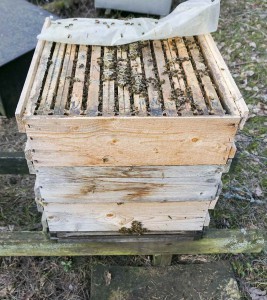 This looks like an ideal colony. Three boxes completely full of bees. It’s heavy, but not as heavy as last fall. There is some room left. I can estimate the weight when lifting the hive a little on both sides. Experience helps here. This colony did not get any super now, even though it had so many bees. They will manage well until it gets one in 1-2 weeks. The next round to the apiaries will be with the car filled with supers and also some food combs that probably will be needed.
This looks like an ideal colony. Three boxes completely full of bees. It’s heavy, but not as heavy as last fall. There is some room left. I can estimate the weight when lifting the hive a little on both sides. Experience helps here. This colony did not get any super now, even though it had so many bees. They will manage well until it gets one in 1-2 weeks. The next round to the apiaries will be with the car filled with supers and also some food combs that probably will be needed.
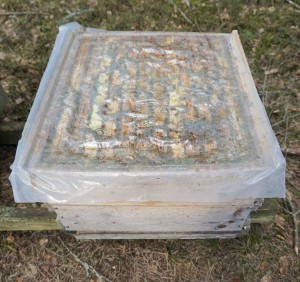 This is also a very good colony, a split from last year wintered on two boxes. Full of bees, plenty of food, but space left for nectar and larvae. They will get their third box in a week or two.
This is also a very good colony, a split from last year wintered on two boxes. Full of bees, plenty of food, but space left for nectar and larvae. They will get their third box in a week or two.
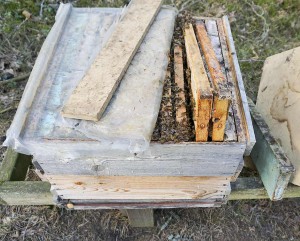 A colony that was more insulated with insulation combs in both boxes. It responded by making brood in late February and March almost using up their food. It’s interesting a smaller colony with a fresh queen can respond in such a way to develop their strength in off season like this. An insulation comb was removed from the light weight side and a comb empty of food had their bees shaken off. The colony was given two combs full of food. On the other more weighty side of the colony, the bees had one full comb of food. That’s the minimum I want for a colony, three combs of food (about 5 kg ≈11 pounds). This colony is the result of a queenless split last year, which failed to make themself a queen. It was united with a split, that had a new laying queen, that was too small to be able to survive winter on their own. This situation probably triggered the more heavily brooding in spite of the smaller size, maybe a survival instinct as the colony had many old bees to start with that probably wouldn’t make it through winter. They had to be replaced in some way.
A colony that was more insulated with insulation combs in both boxes. It responded by making brood in late February and March almost using up their food. It’s interesting a smaller colony with a fresh queen can respond in such a way to develop their strength in off season like this. An insulation comb was removed from the light weight side and a comb empty of food had their bees shaken off. The colony was given two combs full of food. On the other more weighty side of the colony, the bees had one full comb of food. That’s the minimum I want for a colony, three combs of food (about 5 kg ≈11 pounds). This colony is the result of a queenless split last year, which failed to make themself a queen. It was united with a split, that had a new laying queen, that was too small to be able to survive winter on their own. This situation probably triggered the more heavily brooding in spite of the smaller size, maybe a survival instinct as the colony had many old bees to start with that probably wouldn’t make it through winter. They had to be replaced in some way.
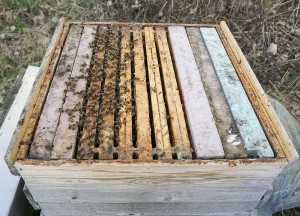 This colony is weakened, the bees sitting close to a insulation comb to keep themselves warm. The bees are covering two full shallows in the top box. They had enough food. Already in November they had started to go down in strength. That’s why several combs were removed and replaced with insulation combs. I could have removed the bottom box, but that will probably be done at the next visit. This colony is questionable if it will survive. Does it has it Nosema and/or virus problems? Next visit will tell.
This colony is weakened, the bees sitting close to a insulation comb to keep themselves warm. The bees are covering two full shallows in the top box. They had enough food. Already in November they had started to go down in strength. That’s why several combs were removed and replaced with insulation combs. I could have removed the bottom box, but that will probably be done at the next visit. This colony is questionable if it will survive. Does it has it Nosema and/or virus problems? Next visit will tell.
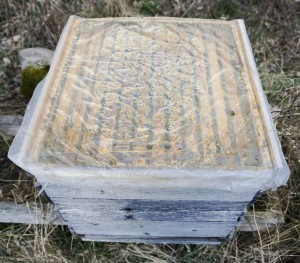 This colony is almost full of bees on three boxes and it is very heavy, as heavy as last fall. It has barely used any food or has collected a lot of willow nectar. The truth is probably a bit of both. The colony has built much new wax on inner cover plastic sheet. It’s too cold (8C=46F) to open up and replace a number of combs with empty drawn ones. The quickest and easiest way is to add a super above an excluder (or without an excluder), which was done.
This colony is almost full of bees on three boxes and it is very heavy, as heavy as last fall. It has barely used any food or has collected a lot of willow nectar. The truth is probably a bit of both. The colony has built much new wax on inner cover plastic sheet. It’s too cold (8C=46F) to open up and replace a number of combs with empty drawn ones. The quickest and easiest way is to add a super above an excluder (or without an excluder), which was done.
Some colonies now in early April got an increase super. In a way it wasn’t needed as the weather still was to cold to really trigger the swarming instinct. But if the boxes of the colony are filled with bees and they either are empty of food or heavy as lead indicating no space left, then they got a box. Five colonies out of about 150 got it. The next round to the apiaries will be focused on increase and the car will be filled with supers with empty drawn 4.9 mm cell size combs. This will happen in 1-2 weeks after this visit.
I’m fascinated how small my bees actually are now!